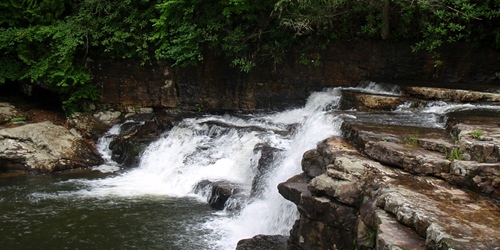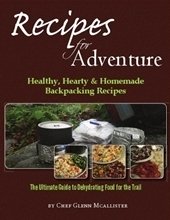Sawyer Water Filter Comparison: Squeeze-Bag vs Pump-Style Backpacking Water Filters
“I’m ditching my Sawyer water filter when I get to town.” That’s what a backpacker told me on the Appalachian Trail. He wanted to lower his pack weight, and he said he knew which water sources were safe.
Why filter water in the backcountry?
I told him about another thru-hiker I had met on the trail who was not filtering water. He was just then getting back on the trail after holing up in town for a week with diarrhea, abdominal cramps, fever, and malaise. He still looked pale and weak.

According to the CDC, Cryptosporidium is a leading cause of waterborne disease among humans in the United States.
After discussing the unpleasant and dangerous effects of Giardia, Cryptosporidium, E. coli, Campylobacter, Salmonella, and Shigella on the human body, I convinced my new friend to trade his 3-oz. Sawyer Squeeze Water Filter for my 2-oz. Sawyer Mini Filter.
I was happy to try out the slightly larger Sawyer filter, and I’m still using it today.
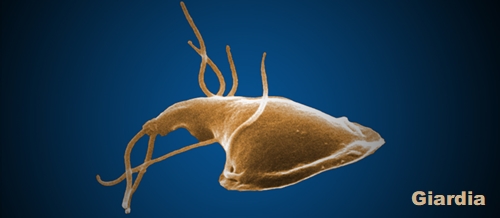
According to the CDC, Giardia, which causes the diarrheal illness known as giardiasis, is found on surfaces or in soil, food, or water that has been contaminated with feces from infected humans or animals.
If you have doubts about the need to protect yourself from waterborne pathogens in the backcountry, take a moment to read this publication from the Centers for Disease Control and Prevention:
A Guide to Drinking Water Treatment and Sanitation for Backcountry & Travel Use
In the absence of a functioning water filter/purification system, the CDC states that boiling water will kill all pathogens. Maintain a full boil for one minute, or for three minutes at altitudes greater than 6,500 feet. (>2000 meters). Boiling water as a sole water purification system for backpacking is not practical, because it uses up fuel and takes too long.
Table of Contents
Disclosure: This article contains links to Amazon. As an Amazon Associate, Backpacking Chef may earn from qualifying purchases. Thank you.
Sawyer Squeeze Water Filters
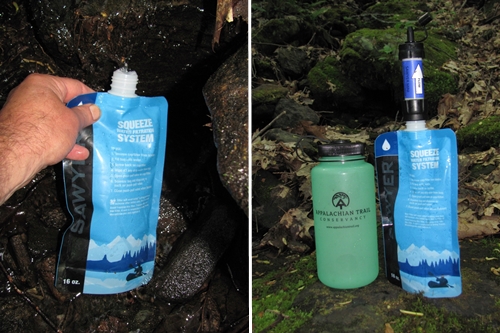
Using a Sawyer water filter is easy:
- Fill bag from water source.
- Attach filter to bag.
- Gently squeeze bag, so water passes through filter into a clean water bottle.
It takes about thirty seconds to filter a liter of water.
For fast hydration on the go, you can drink directly from the clean end of the filter, or screw the filter onto any disposable water bottle that has a standard 28 mm thread. Sawyer also has a kit to adapt the filter to an inline hydration system.
Sawyer water filters come in three sizes. The largest size has the fastest flow rate, but the differences are in seconds, not minutes. Flow rate will decrease as the filter catches particles from the water. Flow rate is easily restored by back flushing the filter with the included cleaning plunger – using clean water.
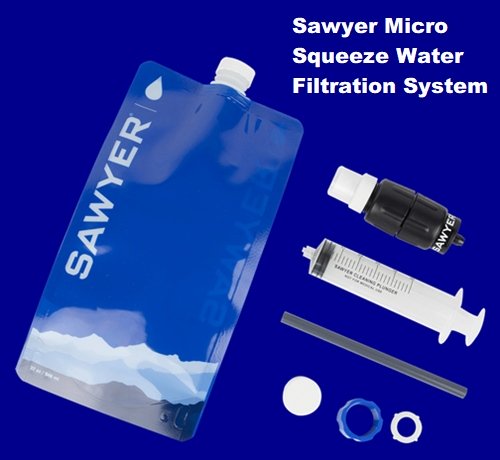
Photo: Sawyer Micro Squeeze Water Filtration System. It’s the smallest Sawyer filter. The included 32-ounce bag weighs a little less than Sawyer’s standard bags.
Reader Contribution: "The Sawyer Micro Squeeze Water Filter has a faster flow than the Mini, plus it can be configured to attach to a bottle in both directions, thanks to an included adaptor. The wonderful thing is that this adaptor also replaces the backwash plunger allowing a field cleaning of your filter without hauling the bulky and a bit heavy plunger. Just connect a clean water bottle to the clean side of the filter using the adaptor, and squeeze. Voila, a backwashed filter.
The best combo with the micro is a Smartwater bottle (700 or 1000ml). These are really light and amazingly strong, so you can squeeze them, and they have a nice shape to put in a backpack pocket (especially one on the shoulder strap). The other bottle can be a Cnoc Outdoors Vecto Collapsible Water Container with 28mm thread. The 3L only weighs 3oz, and you don't have to fill it if you don't need that much. It has a wide opening on the bottom for fast filling in a pond or river, and connects well to the Sawyer micro to create a good gravity system. Hang it to a tree branch draining into the Smartwater bottle." -Geoff R.
Advantages of Sawyer Water Filters
Bags can be filled quickly at most water sources, and you can filter the water later at your campsite or further up the trail. Why is this an advantage? Many water sources are full of mosquitos. Also, on the Appalachian Trail, it’s not uncommon for several people to arrive at the same time at a water source. The “get in and get out” capability of a Sawyer water filter helps the process move faster compared to using pump-style backpacking water filters.
You can fill several bags. Using the Appalachian Trail as an example again, there are many times when the water source is quite a distance from the shelter, or maybe it’s way down a rocky hill. If you fill one or two 64-ounce Sawyer bags, you won’t have to make more than one trip. Another situation that calls for carrying extra water, is when you know that the next water source is a long ways off, or is unreliable.
Unlike backpacking water pumps, Sawyer water filters have no moving parts, which can break. However, applying too much pressure on a bag while filtering water could cause the bag to rupture.
The bags have gusseted bottoms, so they stand upright when full. When empty, they can be easily rolled up.
Disadvantages of Sawyer Water Filters
The Micro and Mini Sawyer Water Filters filter water slower than the larger filter size that comes with the Sawyer Squeeze Water Filter System, which weighs only an ounce more.
The 16-oz. bag that comes with the Mini Filtration System is small for what your needs may require. I recommend purchasing additional 32 oz. and 64 oz. bags to increase filtering and carrying capacity when necessary.
Bags may rupture if you squeeze too hard. Backflush the filter according to instructions to keep a good water flow which will help you avoid putting excessive pressure on the bag. And, of course, patience.
Like almost all other backpacking water filters, a Sawyer Water Filter will not filter out viruses, such as norovirus, which is sometimes present in areas frequented by hikers and campers. A secondary water purification system such as drops, tablets, or UV light pen should be carried.
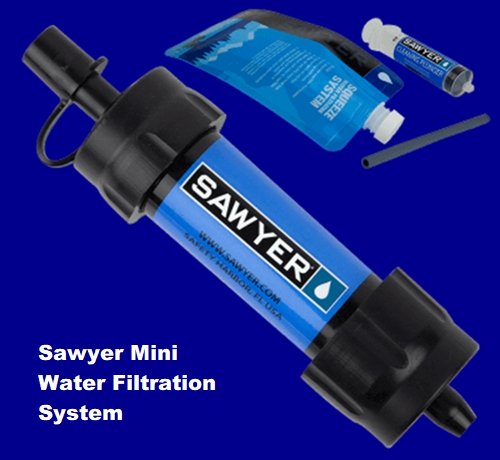
Photo: Sawyer Mini Water Filtration System. Still ultralight at 2-oz, this filter comes with one 16-oz. water collection bag. I recommend buying additional bags in 32-oz. or 68-oz. sizes.
Are Sawyer Water Filters Safe?
Sawyer water filters consist of U-shaped hollow fiber micro-tubes. The pores within these tubes are no larger than .1 micron, which prevents 99.99999% of bacteria (Salmonella, Cholera, and E. coli) and 99.9999% of protozoa (Cryptosporidium and Giardia) from passing through. Viruses, which are less common in the backcountry of the United States, are smaller than .1 microns, so Sawyer water filters do not protect against viruses.
Very few backpacking water filters, pump or squeeze, remove viruses. One exception is the pump-style MSR Guardian™ Purifier. Chemical water treatments, such as Aquamira Water Treatment drops and Katadyn Micropur Tablets, kill viruses, as does a SteriPEN Water Purifier, which uses ultraviolet light.
Sawyer filters do not remove iron, sulfur, and other chemicals.
Backpacking Water Filter Safety Tips
If temperatures dip below freezing, keep the sawyer water filter close
to your body while hiking, or in your sleeping bag during the night. If
water freezes inside the filter, the pores will permanently enlarge, and
the filter will be unreliable against protozoa and bacteria. Since
there is no way to tell, you would have to discard the filter. At home,
don’t store your backpacking filter in a garage or attic that is subject
to freezing temperatures.
Avoid cross contamination. When
filtering water into a clean container, be sure to wipe off any drops of
source water from the Sawyer squeeze bags.
Do not apply too much pressure when squeezing the bags, as that could cause a rupture.
Use only filtered or clean tap water to backflush the filter with the included cleaning plunger.
Carry a backup water purification system, such as Aquamira Water Treatment drops, Katadyn Micropur tablets, or a SteriPen UV light system.
Sawyer Squeeze Filters vs Pump Filters
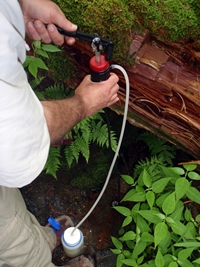
In my experience on the Appalachian Trail, filling a Sawyer Squeeze bag at the water source is easier ninety-percent of the time, compared to using a pump-style water filter.
It gets difficult when the water source is very shallow, with no reachable water trickling down. In this situation, a pump with pre-filter works better.
Shallow Water Tip: Scoop water out with a different container and transfer the water to the bag for filtering. One such container that works well for this is the bottom of a disposable water bottle. Simply cut the top half off. The bottle bottom can be scrunched up for transport with the other bags.
Reader Tip: "One thing that makes using a Sawyer Water Filter easier is a Cnoc Vector water bottle.The entire bottom opens up which makes it easier to scoop water from shallow sources. They make both orange and blue sliders for them, so you can keep one as a dirty bottle and one as a clean bottle, which helps you remember which one is which." -Adam M.
The squeeze bag system shines at any water source where the water is flowing, like a stream, or trickling out of a pipe. I have even collected water from weeping rock cliffs.
It takes about thirty seconds to squeeze a liter of water through a Sawyer filter. Pump filters are also very fast. Water flow slows down considerably if the filters need back flushing or cleaning.
Popular Pump-style Backpacking Water Filters
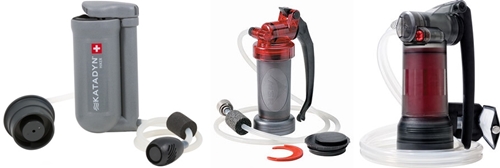
Left to Right:
Other Comparisons of Pump vs Squeeze Filters
Both types of filters – pump or squeeze – effectively remove protozoa
and bacteria. As previously noted, the MSR Guardian™ Purifier also
filters out viruses.
On the trail, you clean pump filters with a
brush or scrub sponge, depending on type. You clean Sawyer filters by
backflushing. Once again, an exception is the MSR Guardian™ Purifier,
which has a unique two-hose, self-cleaning system.
Pump-style backpacking water filters weigh, on average, about a pound more than any of the ultralight Sawyer water filters.
Compared
to my old MSR Sweetwater pump water filter, the newer pump filters
connect directly to a Nalgene bottle, eliminating the need for one of
the hoses.
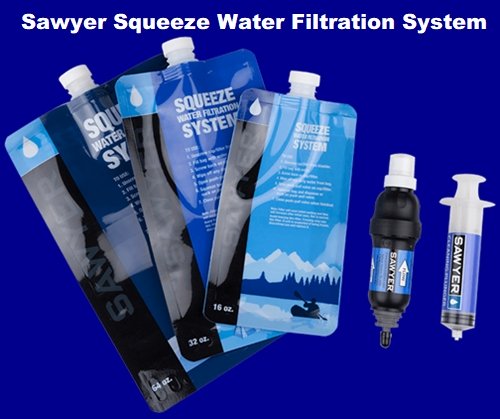
Photo: My choice, the Sawyer Squeeze Water Filtration System.
The filter is slightly larger than the micro or mini, but weighs only an ounce more. It filters water faster than the smaller filters. You can order it with two 32-ounce bags, or with one 16-ounce bag and two 64-ounce bags.
Video: How to Use and Clean a Sawyer Water Filter
What if my Backpacking Water Filter Fails?
As previously noted, boiling water for one minute (three minutes above 6,500 feet/2,000 meters) will kill all pathogens.
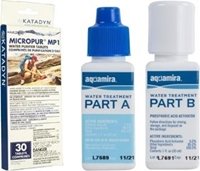
Most backpackers, including myself, carry water purification drops or tablets, in addition to a primary filtering system.
Aquamira Water Treatment Drops and Katadyn Micropur Tablets both purify water – with exceptions – using chlorine dioxide, a safe chemical commonly used by public water treatment facilities. Chlorine dioxide does not contain chlorine or iodine. With Aquamira drops, you mix seven drops from Bottle A with seven drops from Bottle B using the extra cap provided. After waiting five minutes, you add the mixture to a liter of water for purification.
A single Katadyn Micropur tablet will also treat one liter of water. The cost to treat one liter of water is four times higher with Micropur tablets compared to Aquamira Water Treatment drops.
Although both of these water purifiers claim to kill viruses, bacteria, and giardia within thirty minutes, it takes four hours to kill cryptosporidium. For that reason, I use these drops or tablets as an overnight water-purifying backup system.
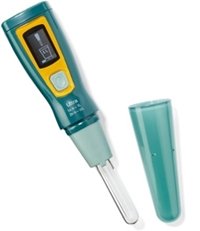
SteriPEN Water Purifier
Another non-filter method of purifying backcountry water is to use a SteriPEN Water Purifier. Using ultraviolet light, SteriPENs kill bacteria, protozoa, and viruses. The water in a one-liter Nalgene bottle is purified in just ninety seconds.
Because SteriPENs are battery dependent, it’s wise to carry one other water filter or treatment system. SteriPENs are only effective in clear water.
Backpacking Chef Reader Comments:
If you would like to add a comment about backpacking water filters or purifiers, you can do that here.
In a quick poll of forty-five Backpacking Chef readers, which asked for the primary filtering method they used on the trail, thirty used a Sawyer Squeeze Water Filter.
Eight people used a pump-style filter, five people used a gravity-feed system, and two people used a SteriPEN.
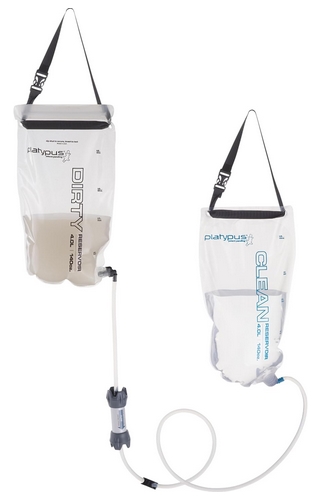
All-in-One Gravity-feed System:
Platypus GravityWorks Water Filter System.
(shown in photo)
Several people were using their Sawyer filters in a gravity-feed setup with Cnoc collapsible bags, rather than the usual squeeze mode.
Reader Comments
Tracy G: I used to have a pump and it was time consuming. I switched to a Platypus
GravityWorks Water Filter System and it is quick and easy. I love it.
Suz B: Platypus Gravity filter! Scoop up water, let gravity do its work while you set up camp.
Seann W: I tried the Sawyer Mini, it was too slow for my liking.
The pressure required resulted in short bag life. I went up to the full
size one and have been quite happy. My water bladder has a quick connect
input, so I fitted a spare bit of hose with the other gender and now I
gravity filter exclusively. The extra ounce means no concerns about
burst bags, and I can snack while my bag fills up. Cutting the top off
an old leaky Sawyer Water Filter bag also makes for a good scooper, and
it packs flat to boot.
Rob H: Squeeze or gravity. I used
to pump, but when the pump broke on Day 2 of a 6-day trip, I decided to
switch. Not as much to break.
Steinar B: Katadyn BeFree 1.0L Water Filter
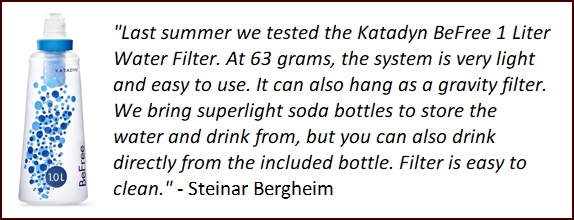
Gwen T: SteriPEN. The only dislike is that I have to carry a wide-mouth bottle to accommodate the process (that and remembering to put in fresh batteries at the beginning of the backpacking season).
Tim S: Gwen, have you tried putting the pen into your regular bottle and inverting it? Works fine for me. You just swirl the bottle instead of the pen.
Sandy C: Squeeze for when on the go, gravity when I have more time. I also purify after filtering. Pumps have a lot of breakable parts.
Liz Y: Sawyer Squeeze. In the winter I use the SteriPEN.
Paul M: Gravity with the Sawyer 2-liter bag system and Squeeze when needed.
John Y: The Katadyn Hiker filters I bought in the 90s pumped great for about a day, but then got harder and harder. Since then I've bought both Platypus Gravity and Sawyer Squeeze, which I modified to gravity. You use the "dirty water" bag, fill with the cleanest surface water you find, then go do other stuff or just sit back and be amazed at the filtering speed. I bring the syringe they provide to flush the filter with clean water, but it's never slowed on a trip. At the end of each trip just do the standard flush followed by a diluted bleach rinse.
Christopher K: Was gravity, now I'm pump purifier with MSR Guardian. And a filtered Nalgene bottle.
Chef Glenn: The MSR Guardian looks attractive in that it also filters viruses, but, wow, the price!
Another nice feature of the MSR Guardian is that it is self-cleaning.
Mary W: Christopher, I have the MSR Guardian and am looking forward to putting it to use in the spring. I also have a Platypus Gravity. I know it weighs more, but think I will like the Guardian better, as my guide dog won’t have to wait for water if we run out.
Christopher K: Absolutely the cost of the MSR Guardian is a major problem. The product itself has flaws. The gasket that seals the filter has been a problem since release. However, when it comes down to timely purifying water, (Also traveling with a dog) there are no substitutes.
Tom S: Christopher, I’ve been using the MSR Guardian for a few years. I agree, it does have its flaws. I was disappointed in the plastic handle... seems rather weak, especially seeing as how it was supposedly made for the military. The Cotter pin fell out once when pumping, but luckily I had eyes on it. The biggest concern; last summer it got very difficult to pump for some reason. Had to finish the trail piggybacking with my hiking partner’s Katadyn. Anyone else have any history with this? Mine’s only four years old.
Christopher K: Tom, I would say do the obvious thing and remove the filter and see if that's just clogged. If that’s not the problem, it might be the pump itself. See what the annual service kit comes with. Also, do the integrity test to see if it passes.
John S: MSR MiniWorks EX Water Microfilter. It’s not the lightest, but I have pumped out of puddles when water sources were scarce. You can clean the ceramic filter in the field. Screws onto a Nalgene bottle, so there’s no contamination.
Greg S: I use a Sawyer squeeze that I set up as a gravity filter when at camp and squeeze while on the go.
Paul T: Pumps are heavy and have a lot of moving parts that can break. They are also generally difficult to clean. The advantage most pumps have is a carbon filter, but you can add that to a squeeze system.
Joslyn E: Sawyer Squeeze! I don't mind being the mechanism that pushes water through the filter. I don't break down like a pump can.
Todd N: Sawyer Squeeze in a gravity feed setup works great. I also carry a couple of 64-oz. pouches for a quick squeeze fill up on the trail and additional water carrying capacity in places with no easy access to a water source. We upgraded last year from the Sawyer Mini, which works good, but I really like the faster flow rate of the full size Squeeze, especially filtering for two people, multiple days on the trail.
TJ: I have a MSR pump somewhere, but haven’t used it for a couple of years. I like Sawyer filters. On top of a bottle if I’m on the move. Gravity while I’m in camp. Use pills occasionally, if I’m out while it’s freezing.
Bonnie N: Katadyn pump is my go to. We also have a larger gravity system that is nice to take along when it’s a family backpacking trip. We set it up, and it filters as we do other camp chores. I also have a LifeStraw, but never use it.
Steve A: I’ve broken several squeeze filters. While the added weight and price of the Katadyn Pocket Water Filter is a big negative, the thing is bomb-proof and field serviceable. I’ve had mine for about five years or so and will never regret the cost of ownership.
Emily S: I use an inline squeeze with a bladder. In camp, we hang it and make it into a gravity filter.
Wendy S: My LifeStraw never worked properly. The pump is the way to go.
Marijka W: Had a really good MSR pump for years, but now do the thru-hiker thing with a standard Sawyer Squeeze and disposable water bottle with sport top.
Greg K: Moved to squeeze/ gravity feed because there are less moving parts and easier to field maintain if it clogs or the handle (none) breaks.
Juli W: SteriPEN (so fast!) and Aquamira drops work while walking. Squeeze just takes too much of my time and hanging requires waiting, which is fine if you’re at the end of your day, setting up tents etc.
Joel D: We use the Sawyer Squeeze. Used it on a 10-day canoe trip with no issues. I kept it in my pocket when the temp was very cold to prevent freezing.
Mary T: We have used Sawyer for years. Never had a problem. I keep a Sawyer Mini in my purse as city water is questionable. Never travel without it. This is an example of hiking gear becoming a regular essential item.
Leya C: Sawyer Squeeze with a silicone bag from CNOC Outdoors. Tried four other filters for years and this is now the only one I'll use when backpacking! For international I use a Grayl bottle.
Dominique M: When water sources are scarce, we carry one 32-oz. Sawyer Squeeze Bag and two of the large 64-oz. bags with the Sawyer Filter: Sawyer
Squeezable Pouches.
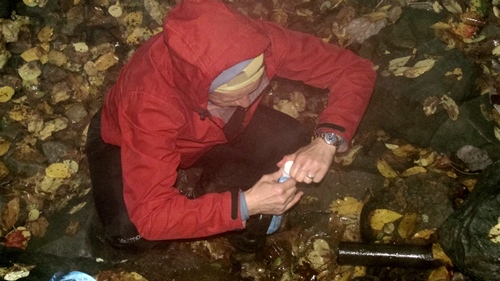
Photo: Dominique filling Sawyer squeeze bags at a water source in Shenandoah National Park.
Share this page with friends on social media.
Free E-book & Newsletter
Free with Trail Bytes subscription.
Dehydrating Food from A–Z

